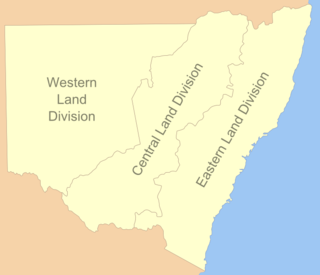A pastoral lease, sometimes called a pastoral run, is an arrangement used in both Australia and New Zealand where government-owned Crown land is leased out to graziers for the purpose of livestock grazing on rangelands.
In the Australian states and territories, leases constitute a land apportionment system created in the mid-19th century to facilitate the orderly division and sale of land to European colonists. Legislation ensured that certain Aboriginal rights were embodied in pastoral leases. However, according to historian Henry Reynolds, several colonial leaders ran roughshod over these rights, including Sir John Downer (when the Northern Territory was governed by the colonial government of South Australia); Sir John Forrest in the colony of Western Australia; and Sir Samuel Griffith in Queensland. [1]
Pastoral leases exist in both Australian commonwealth law and state jurisdictions. They do not give all the rights that attach to freehold land: there are usually conditions which include a time period and the type of activity permitted. According to Austrade, such leases cover about 44% of mainland Australia (3,380,000 km2 (1,310,000 sq mi)), mostly in arid and semi-arid regions and the tropical savannahs. They usually allow people to use the land for grazing traditional livestock, but more recently have been also used for non-traditional livestock (such as kangaroos or camels), tourism and other activities. Management of the leases falls mainly to state and territory governments. [2] Leases within state jurisdictions have variations as to applicability from state to state.
Under Commonwealth of Australia law, applicable only in the Northern Territory, they are agreements that allow for the use of Crown land by farmers. [3]
Native title can co-exist with pastoral leases, and Indigenous land use agreements may be made between the leaseholder and the affected native title group. [2]
Australian jurisdictions have land management legislation that affects the administration of pastoral leases. [4] As of November 2023 [update] the legislation and management arrangements are as follows:
The statutory provisions of pastoral leases are covered by the New Zealand Crown Pastoral Land Act 1998 and the Land Act 1948 . The holder of the lease has: [11]

Wik Peoples v The State of Queensland is a decision of the High Court of Australia delivered on 23 December 1996, on whether statutory leases extinguish native title rights. The court found that the statutory pastoral leases under consideration by the court did not bestow rights of exclusive possession on the leaseholder. As a result, native title rights could coexist depending on the terms and nature of the particular pastoral lease. Where there was a conflict of rights, the rights under the pastoral lease would extinguish the remaining native title rights.

Crown land, also known as royal domain, is a territorial area belonging to the monarch, who personifies the Crown. It is the equivalent of an entailed estate and passes with the monarchy, being inseparable from it. Today, in Commonwealth realms, crown land is considered public land and is apart from the monarch's private estate.
A leasehold estate is an ownership of a temporary right to hold land or property in which a lessee or a tenant has rights of real property by some form of title from a lessor or landlord. Although a tenant does hold rights to real property, a leasehold estate is typically considered personal property.
Native title refers to rights, recognised by Australian law, held by Aboriginal and Torres Strait Islander groups or individuals to land that derive from their maintenance of their traditional laws and customs. These Aboriginal title rights were first recognised as a part of Australian common law with the decision of Mabo v Queensland in 1992. The doctrine was subsequently implemented and modified via statute with the Native Title Act 1993.

The state of New South Wales is divided into three divisions: the Eastern Division, the Central Division, and the Western Division. These were established for the purposes of the management of the lease of Crown land to private persons. The Western Division includes Broken Hill, Bourke, Cobar, Cockburn, Walgett, Wentworth as well as the western land boards of Forbes, Griffith, Rankins Springs, West Wyalong, White Cliffs, Wyalong, Conargo, Hay and Parkes.

The Aboriginal Land Rights Act 1976 (ALRA) is Australian federal government legislation that provides the basis upon which Aboriginal Australian people in the Northern Territory can claim rights to land based on traditional occupation. It was the first law by any Australian government that legally recognised the Aboriginal system of land ownership, and legislated the concept of inalienable freehold title, as such was a fundamental piece of social reform. Its long title is An Act providing for the granting of Traditional Aboriginal Land in the Northern Territory for the benefit of Aboriginals, and for other purposes.
Australian property law, or property law in Australia, are laws that regulate and prioritise the rights, interests and responsibilities of individuals in relation to "things" (property). These things are forms of "property" or "rights" to possession or ownership of an object. Property law orders or prioritises rights and classifies property as either real and tangible, such as land, or intangible, such as the right of an author to their literary works or personal but tangible, such as a book or a pencil. The scope of what constitutes a thing capable of being classified as property and when an individual or body corporate gains priority of interest over a thing has in legal scholarship been heavily debated on a philosophical level.

The states and territories are the second level of government of Australia. The states are administrative divisions that are self-governing polities that are partly sovereign, having ceded some sovereign rights to the federal government. They have their own constitutions, legislatures, executive governments, judiciaries and law enforcement agencies that administer and deliver public policies and programs. Territories can be autonomous and administer local policies and programs much like the states in practice, but are still legally subordinate to the federal government.

The Native Title Act 1993(Cth) is a law passed by the Australian Parliament, the purpose of which is "to provide a national system for the recognition and protection of native title and for its co-existence with the national land management system". The Act was passed by the Keating government following the High Court's decision in Mabo v Queensland (No 2) (1992). The Act commenced operation on 1 January 1994.

In the history of Australia, squatting was the act of extrajudicially occupying tracts of Crown land, typically to graze livestock. Though most squatters initially held no legal rights to the land they occupied, the majority were gradually recognised by successive colonial authorities as the legitimate owners of the land due to being among the first white settlers in their area. The term squattocracy, a play on aristocracy, was coined to refer to squatters as a social class and the immense sociopolitical power they possessed.
Selection is the act of choosing and acquiring a subdivided tract of land for farming purposes in Australia. A selection is also descriptive of the plot of land that was selected. The term derived from "free selection before survey" of crown land in some Australian colonies under land legislation introduced in the 1860s. These acts were intended to encourage closer settlement, based on intensive agriculture, such as wheat-growing, rather than extensive agriculture, such as wool production. Selectors often came into conflict with squatters, who already occupied the land and often managed to circumvent the law.
Land councils, also known as Aboriginal land councils, or land and sea councils, are Australian community organisations, generally organised by region, that are commonly formed to represent the Indigenous Australians who occupied their particular region before the arrival of European settlers. They have historically advocated for recognition of traditional land rights, and also for the rights of Indigenous people in other areas such as equal wages and adequate housing. Land councils are self-supporting, and not funded by state or federal taxes.
Australian mining law governs the exploration and extraction of minerals and petroleum in Australia. It differs substantially from the mining laws of other common law countries, the most important differences arising from the policy decision that the Crown should own all minerals.
Commonwealth, State, and Territory Parliaments of Australia have passed Aboriginal land rights legislation.
Indigenous land rights in Australia, also known as Aboriginal land rights in Australia, are the rights and interests in land of Aboriginal and Torres Strait Islander people in Australia; the term may also include the struggle for those rights. Connection to the land and waters is vital in Australian Aboriginal culture and to that of Torres Strait Islander people, and there has been a long battle to gain legal and moral recognition of ownership of the lands and waters occupied by the many peoples prior to colonisation of Australia starting in 1788, and the annexation of the Torres Strait Islands by the colony of Queensland in the 1870s.
In Australia, an Aboriginal land trust (ALT) is a type of non-profit organisation that holds the freehold title to an area of land on behalf of a community of Aboriginal Australians. The land has been legally granted to a community by the government under a perpetual lease, usually after the community makes a formal claim of traditional ownership. Land granted under Aboriginal title is inalienable; it can not be bought, sold, traded or given away. The land trust is the organisation appointed by the community to legally hold the title deeds. The land trusts are administered by Aboriginal land councils.
The Waanyi people, also spelt Wanyi, Wanji, or Waanji, are an Aboriginal Australian people from south of the Gulf of Carpentaria in Queensland and the Northern Territory.

The process of land selectionin Queensland in Australia began in 1860. It continued under a series of land acts in subsequent years. When Britain claimed possession of Australia, it did so based on terra nullius and did not acknowledge that Indigenous people had any ownership over the land. All land in Australia became Crown land and was sold or leased by the Australian colonial governments according to the needs of the colonists.

Central Australia was a territory of Australia that existed from 1927 to 1931. It was formed from the split of the Northern Territory in 1927 alongside the territory of North Australia, the dividing line between the two being the 20th parallel south. The two territories were merged in 1931 to reform the Northern Territory. The seat of government of the territory was Stuart, a town that was commonly known as "Alice Springs" and would be officially renamed so in 1933.
{{citation}}: CS1 maint: numeric names: authors list (link)